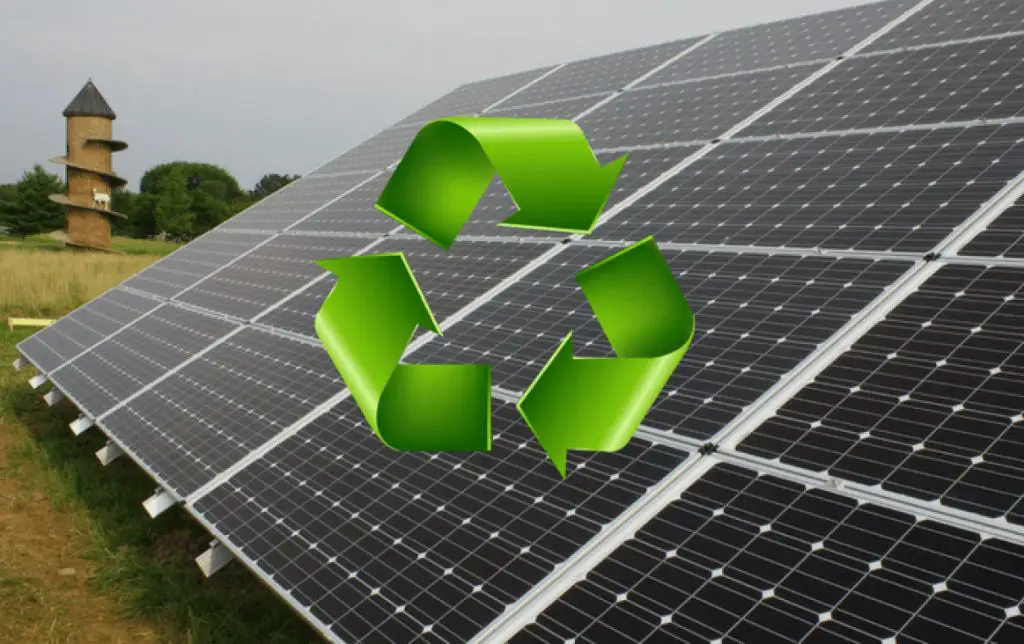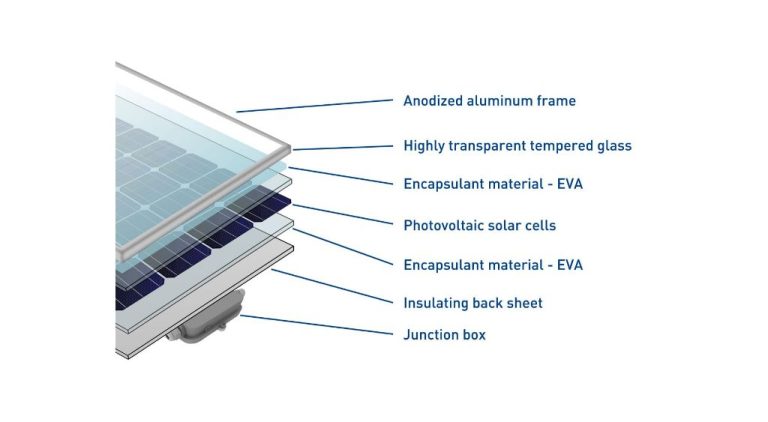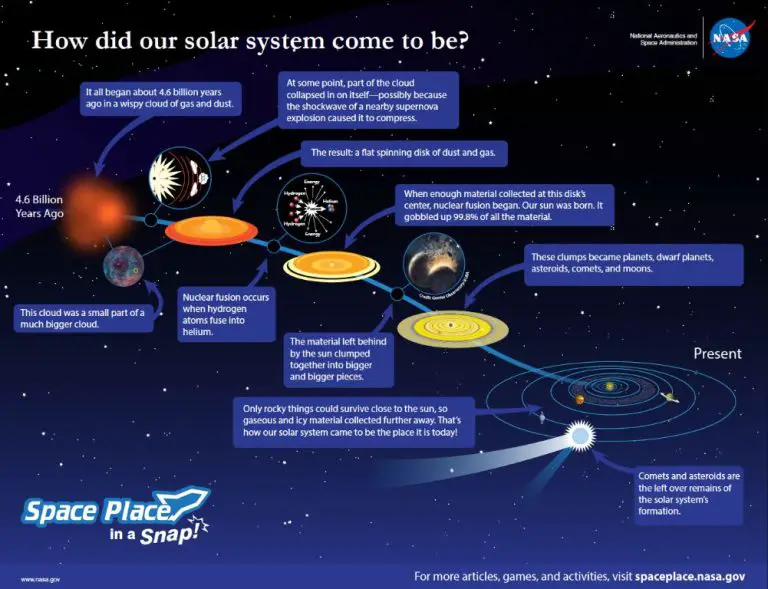Can Solar Panels Be 100% Recycled?

Solar panels are made up of several key components that work together to convert sunlight into electricity. The most important material is silicon, which makes up the solar cells that absorb photons from sunlight and generate an electric current. Silicon is abundant, non-toxic, and has ideal properties for capturing solar energy. The silicon in solar panels comes in different forms like monocrystalline, polycrystalline, and amorphous silicon. Solar cells are assembled together and sealed between a glass front panel and a polymer backing to protect them. Solar panels also have aluminum framing, junction boxes, and wiring to carry the electricity produced. This combination of silicon solar cells, protective casing, and electrical components allows solar panels to efficiently harness the power of the sun.
Solar Panel Lifespans
The average lifespan of solar panels is 25-30 years, but they can last over 40 years if properly maintained. Most solar panels come with a 25-30 year performance warranty that guarantees a certain level of power output (typically 80%) over that timeframe (Source).
Solar panels may need replacing due to degradation of materials over decades of exposure to the elements. The solar cells can lose efficiency over time, reducing power output. Wires, connectors and junction boxes can also degrade. Extreme weather like hail storms or hurricanes can damage solar panels. Regular maintenance and inspections are important to maximize lifespan.
Another reason to replace solar panels is if newer technology becomes available that is significantly more efficient or cost-effective. Upgrading aged solar panels to newer models can help maintain or increase power production. However, existing solar panels typically do not need replacing just for moderate efficiency gains.
Recycling Challenges
Solar panels are difficult to recycle for a few key reasons. First, they contain toxic and potentially hazardous materials that require special handling. The main concerning components are:
- Silicon cells – Made from crystalline silicon and gallium arsenide, which are hazardous in dust form.
- Encapsulant – Often made from EVA plastic which is difficult to separate and recycle.
- Wires – Can contain lead which requires careful removal and disposal.
- Glass – Specially hardened with materials like antimony to withstand weather. Normal glass recycling cannot handle these coatings.
- Aluminum frames – Relatively easy to recycle but still require separation from other components.
In addition, solar panels are designed to last 25-30 years. Newer recycling processes are just being developed now, meaning there are limited facilities equipped to handle the unique recycling needs. The toxicity and durability of materials make processing more complex.
Recycling Methods
Currently, there are two main methods for recycling solar panels – mechanical and chemical recycling. In mechanical recycling, the panels are physically broken down and materials are separated. This involves shredding and crushing the panels to break them into smaller pieces. Metals and silicon can then be separated using magnets, eddy current separators, shakers, and optical sorting. However, mechanical recycling cannot perfectly separate all materials [1].
Chemical recycling uses chemical baths to separate the panel materials. The panels are first shredded into pieces and then submerged in chemical baths. This allows materials like silver and copper to be dissolved and extracted. The polymers are also dissolved, leaving behind silicon particles. While very thorough, chemical recycling is more complex and involves dealing with hazardous chemicals [2].
New hybrid methods are also emerging that combine both mechanical and chemical techniques for improved recycling. For example, mechanical shredding and separation can be followed by chemical baths to refine the material separation [3].
Recycling Rates
The recycling rate for solar panels is currently very low. According to a 2021 report from the National Renewable Energy Laboratory (NREL), only 10-15% of solar panels are recycled in the United States [1]. In the European Union, recycling rates are higher at around 85% [2].
There are several barriers leading to low solar panel recycling rates in the U.S. First, there is a lack of infrastructure and facilities capable of recycling solar panels in an economically viable way. It is often still cheaper to send panels to landfills rather than recycle them. Additionally, many consumers and solar installers are unaware of recycling options or requirements. There is also a lack of policies and regulations around solar panel recycling compared to the E.U. Finally, the technology for profitably extracting and reusing materials from solar panels is still developing.
Recycling Costs
The economics of solar panel recycling present challenges. Recycling companies often lose money in the process due to high costs and low yields of recovered materials. As a result, many panels end up in landfills instead of being recycled. According to one source, “There is a real gap between the cost to recycle solar panels and the value of the materials that you’re deriving from that process. It’s very expensive to recycle solar panels in a responsible way” (Mass.gov).
Typically the cost of recycling falls on solar panel owners or installation companies rather than manufacturers. Prices can range from $10-20 per panel according to one estimate (SolarAnswered). Recycling costs also include transportation and processing fees. As a result, recycling rates remain low since owners must pay out of pocket, despite growing interest in sustainability.
Lowering recycling costs through improved efficiency, economies of scale, and manufacturer responsibility could increase recycling rates in the future. But for now, it remains more expensive to recycle solar panels than to produce new ones from raw materials.
Future Improvements
There are optimistic projections regarding advancements in solar panel recycling processes and technologies in the coming years. Many experts believe that new solar panel designs will be engineered with end-of-life recyclability in mind. For example, researchers are developing solar panels that can be more easily disassembled into individual components for recycling at the end of their lifespan (The Future of Solar Panel Recycling: A Circular Economy Insight). Companies like First Solar have pioneered thin-film solar panel technology that contains only benign, recyclable semiconductor materials like silicon, making recycling simpler and more cost effective.
There is growing optimism that recycling rates for key solar panel materials like silicon, silver, copper and aluminum will continue to rise as new specialized recycling processes are developed. Many experts predict that dedicated solar panel recycling infrastructure and efficient automated recycling systems will emerge within the next decade, allowing for more cost-effective, large-scale recycling (The Future of Solar Panel Recycling). This is expected to create a profitable solar panel recycling industry and move the economics further in favor of recycling versus landfill disposal. Overall, continual improvements in solar panel recycling technology along with economies of scale are projected to make recycling an increasingly viable end-of-life option for solar panels.
Recycling Policies
There are currently no federal recycling mandates specifically for solar panels in the United States. However, some states have implemented their own solar panel recycling policies and incentives. Washington was the first state to pass a solar panel stewardship and takeback program in 2017, requiring manufacturers selling solar panels in the state to have a recycling plan in place (Source). California followed with mandates through SB 489 requiring solar companies to have recycling plans when selling solar panels in the state starting in 2021 (Source). Financial incentives like rebates are also being offered in states like Minnesota to recycle old solar panels. More states are expected to implement solar panel recycling mandates as installations continue to grow.
Consumer Role
Consumers play a crucial role in enabling the effective recycling of solar panels. Proper disposal by consumers is the first step in the recycling process.
Consumers should return solar panels to certified recyclers rather than disposing of them as normal waste. Most solar panel manufacturers and installers have take-back programs where they will collect and recycle old solar panels. Consumers can also use third party recycling services that specialize in solar panel recycling. Energy5.com highlights the importance of consumer education in promoting recycling and ensuring panels are returned to recyclers rather than landfills.
When it’s time to replace their solar panels, consumers should do their research to find responsible recyclers rather than choosing the cheapest or most convenient option. Asking installers about end-of-life procedures and policies can encourage more recycling. Consumers can also advocate for stronger recycling regulations and incentives in their local areas.
Overall, engaged and informed consumers have the power to significantly increase solar panel recycling rates by taking responsibility to dispose of their panels properly. Simple actions like returning panels for recycling and asking installers the right questions enable the solar industry to achieve higher recycling and material recovery rates.
Sources:
https://energy5.com/role-of-consumer-education-in-scaling-solar-energy-adoption
Conclusion
In summary, while not all solar panels are currently 100% recyclable, the recycling rates are improving each year as new technologies and processes are developed. Most panels can be recycled at least partially today, with typical recycling rates of 80-90% of panel components by weight.
The outlook for 100% solar panel recyclability in the future is promising. With rising volumes of solar panel waste, there are strong economic incentives for further improvements in recycling processes and technology. Some experts predict solar panel recycling could become fully commercially viable and maximize value recovery from these materials within 5-10 years.
While currently not fully comprehensive, solar panel recycling diversion from landfills is already substantial and rapidly increasing. With coordinated efforts by industry, government and consumers, the goal of extracting maximum value through 100% recycling of solar panels at end-of-life is an achievable sustainability target.




